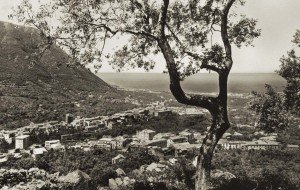The ancient art of making pasta from durum wheat semolina has a very long tradition in Gragnano.
The history of pasta on the “magic” hill of this little town, very close to Naples, started more than 500 years ago.
This story begins around the middle of the 16th century with the generous gifts Na ture granted to this pleasant town, hidden between the sea and the mountains, with its ideal climate for producing and drying pasta.
ture granted to this pleasant town, hidden between the sea and the mountains, with its ideal climate for producing and drying pasta.
In the underlying valley, today known as “Mills’ Valley”, there were several mills fed by fresh and plentiful mountain springs, another of the precious Nature’s gift to Gragnano. The closeness to the mills made it easier to bring the main raw material, the semolina, obtained milling durum wheat.
The semolina from the mill, mixed with fresh spring water gave a very characteristic taste to the pasta.
However, the key role was played by the unique climate of Gragnano: warm, but not too humid, due to the sea breeze. For its climatic characteristics, Gragnano became an ideal place for drying pasta, that originally was dried in the sun, exposed along the city roads. Pasta dried slowly, in a climate with an almost steady temperature and humidity, so that the result was a tasteful product, that could be stored for a long time with no risk of deterioration or contamination.
This is an authentic Italian Pasta, the shapes are made by turning on bronze dries. This is the traditional method of forming Pasta. It roughens the surface so the shape holds more sauce.
This article is taken from http://www.melodiafood.co.uk/




